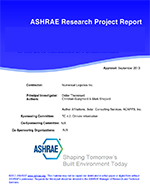Description
There is great energy-saving potential in reducing variable air volume (VAV) box minimum airflow setpoints. In the past, setpoints have been maintained at high levels because of three concerns: 1) low flows might cause the occupants draft discomfort from insufficient mixing of diffuser discharge air, 2) inability of VAV boxes to control at low flows, and 3) poor air quality resulting from a combination of poor control and insufficient diffuser mixing. It is worth examining these concerns to see whether they are justified. The controller accuracy and stability have recently been addressed by RP 1353, in which VAV boxes were found to control well at very low flow levels. The diffuser mixing issue and impact on comfort are addressed in this research project, RP 1515.
RP 1515 is a combined field and laboratory study, in which occupants’ thermal comfort and air quality satisfaction is evaluated in the field under reduced minimum VAV flow rate setpoints, and the mixing performance of diffusers is measured in the laboratory. The laboratory portion was performed with co-funding from Price Industries. Additional co-funding from the California Energy Commission’s PIER program allowed us to quantify the HVAC energy savings resulting from the reduced flows in the field study buildings.
Product Details
- Published:
- 2015
- Number of Pages:
- 285
- File Size:
- 1 file , 11 MB
- Product Code(s):
- D-RP-1515




